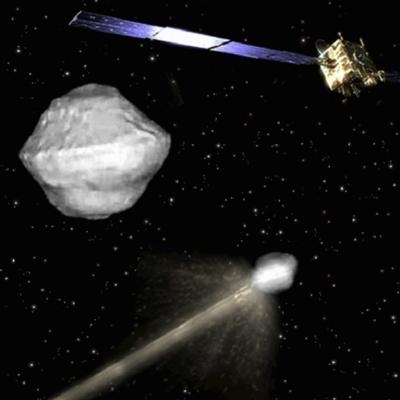Fri, Jan 18, 2013
Seeking Improved Understanding Of High-Speed Collisions Between Natural And Man-Made Objects
A space rock several hundred metres across is heading towards our planet and the last-ditch attempt to avert a disaster – an untested mission to deflect it – fails. This fictional scene of films and novels could well be a reality one day. But what can space agencies do to ensure it works?

ESA is seeking research ideas to help guide the development of a US–European asteroid deflection mission now under study.
Concepts are being sought for both ground- and space-based investigations, seeking improved understanding of the physics of very high-speed collisions involving both man-made and natural objects in space. ESA’s call will help to guide future studies linked to the Asteroid Impact and Deflection mission – AIDA. This innovative but low-budget transatlantic partnership involves the joint operations of two small spacecraft sent to intercept a binary asteroid. The first Double Asteroid Redirection Test (DART) spacecraft, designed by the US Johns Hopkins Applied Physics Laboratory will collide with the smaller of the two asteroids.
Meanwhile, ESA’s Asteroid Impact Monitor (AIM) craft will survey these bodies in detail, before and after the collision. The impact should change the pace at which the objects spin around each other, observable from Earth. But AIM’s close-up view will ‘ground-truth’ such observations. “The advantage is that the spacecraft are simple and independent,” says Andy Cheng of Johns Hopkins, leading the AIDA project on the US side. “They can both complete their primary investigation without the other one.”
But by working in tandem, the quality and quantity of results will increase greatly, explains Andrés Gálvez, ESA AIDA study manager: “Both missions become better when put together – getting much more out of the overall investment. “And the vast amounts of data coming from the joint mission should help to validate various theories, such as our impact modeling.”
(ESA image artist's concept of AIDA mission)
More News
DETRESFA (Distress Phrase) The code word used to designate an emergency phase wherein there is reasonable certainty that an aircraft and its occupants are threatened by grave and i>[...]
"General aviation is at the forefront of developing and introducing innovative technologies that will transform the entire aviation industry..." Source: Kyle Martin, Vice President>[...]
Direct Straight line flight between two navigational aids, fixes, points, or any combination thereof. When used by pilots in describing off-airway routes, points defining direct ro>[...]
Aero Linx: Women in Corporate Aviation Women in Corporate Aviation support individuals seeking career advancement and professional development in the business aviation industry. Me>[...]
“We would like to thank the many volunteers that help throughout the year to pull off the event, as well as the several reviewers, judges, and SURVICE staff that provide team>[...]
 ANN's Daily Aero-Term (04.26.24): DETRESFA (Distress Phrase)
ANN's Daily Aero-Term (04.26.24): DETRESFA (Distress Phrase) Aero-News: Quote of the Day (04.26.24)
Aero-News: Quote of the Day (04.26.24) ANN's Daily Aero-Term (04.27.24): Direct
ANN's Daily Aero-Term (04.27.24): Direct ANN's Daily Aero-Linx (04.27.24)
ANN's Daily Aero-Linx (04.27.24) Aero-News: Quote of the Day (04.27.24)
Aero-News: Quote of the Day (04.27.24)



